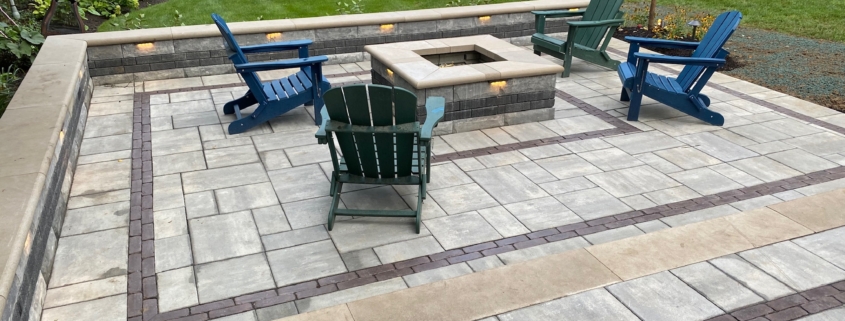Paver Patios vs. Concrete: Which Is Better?
“Better” is certainly a subjective word! What’s right for one person may not hit the mark for another; what looks terrific across the street may not be a great option for your own backyard. In other words: “better” versus “best” is up to you, your style, your goals and budget. So, when it comes to your property and hardscape, should you go with pavers or concrete for your patio?
A true battle for the ages! Let’s find the winner for you.
Looking for Patio Perfection?
You may be thinking, “Who cares?! Just put something down so we can get outside, entertain friends and family, and make the most of our patio!” We get it… but selecting the right material now will ensure you reach your goals this year and enjoy your space season after season. What patio materials can you choose from?
Concrete is a material made from aggregate (typically gravel and sand) that is bonded, or held together, by cement and water. A remarkable product, it is one of the most widely used manmade resources. It’s in everything from roads, bridges, and dams to our home’s slabs, foundations, driveways, and yes, patios.
Pavers are made of natural stone, clay brick, porcelain, or other materials. Typically, they are small pieces that vary in size. Think of them as an outdoor sibling to the tiles you’d install for your bathroom floor or kitchen backsplash. In the same way, you can choose different substances, colors, textures, and patterns.
In the context of a patio, how do these options stack up?
Paver Patios vs. Concrete
We know you want to get outdoors to entertain, cook, and just relax with a good book and a cold glass of lemonade. The right patio surface makes all the difference.
As you make your selection, think about:
Cost
At the end of the day, we are all asking, “How much is this going to cost?” Good question. Better question, “How much will this cost me now, and how much will it cost me for future fixes?”
The initial cost of installing a concrete patio is lower than doing a paver patio. Pavers are 10 – 15% more expensive than concrete. You may spend $3 to $7 per square foot for concrete versus $8 – $25 for pavers. But pricing doesn’t tell the whole story.
Installation
One of the big benefits of concrete is that it is quick and easy to install. They pour, it cures, you have a solid finished product. It takes a few hours to pour a concrete patio, though it takes a few days to fully cure. With pavers, you’re looking at a slightly longer process. You need to remove debris (e.g., grass and dirt), level the subsoil, install and level gravel, bedding sand, and pavers, install edging, fill joints, and clean and seal the surface.
Pavers are, undoubtedly, more labor intensive, and you may have to wait a few more days to enjoy your backyard oasis. As we often hear, though, a solid foundation (in relationships, education, building, etc.) is the key to longlasting success.
Durability
We’re getting to the crux of the cost issue: durability is a major concern. Typically, pavers can withstand up to 8000 psi (pounds per square inch), while concrete can only handle up to 2500 psi. If you plan on using your patio for weekend gatherings, morning coffee and evening cocoa or cocktails, for … well, everything….
You need to be aware that you are putting a lot of strain on the surface. Pavers stand the test of time, compared to concrete. When they are installed properly, pavers create a strong, interlocking pattern that is far less vulnerable to breaking and cracking.
This is an important consideration in our neck of the woods; we deal with multiple freeze and thaw cycles. In a concrete patio, this can cause expansions and contractions that create weak spots, cracks, and “frost heaves.” Paver patios are designed to accommodate for these conditions.
Drainage is another issue: concrete is only a little less porous than your average dish sponge! It absorbs a lot of water, and this leads to degradation of the surface. Pavers are able to drain water effectively, dispersing it into the ground rather than pooling it into the surface.
Repair
What if your concrete cracks? You need to redo the entire patio, and the results can be pretty rough. Concrete tends to show its scars, so to speak. Repairs are usually very visible.
What if a paver is loose or damaged? You just pull out the problem area, secure the base, and reinstall the paver(s). Often, contractors leave you with extra pavers, so this is a relatively easy DIY job. Even if you do call in a pro, it’s quick and simple.
Aesthetic
This is one of those highly subjective factors! Choosing between a solid concrete surface or a patterned paver layout is up to your preference. We find that the versatility and variety of pavers makes them a great fit for lots of folks.
Make Your Patio Plan a Reality
Concrete vs. patio pavers: which is best for you? If you’re not sure, or if you are sure and want to start your improvement project, get in touch. Our team will guide you through every step of the process, from product selection to design to installation. Contact GreenImage to talk about your ideas, goals, and needs and/or schedule a free consultation.



